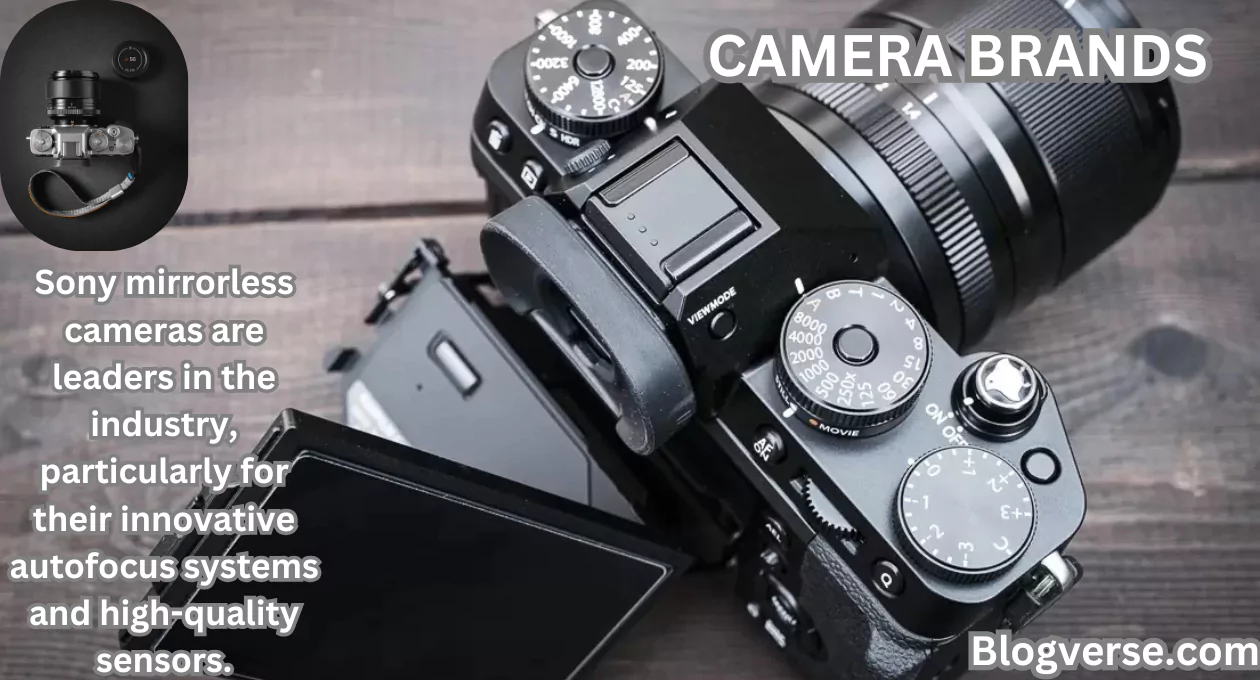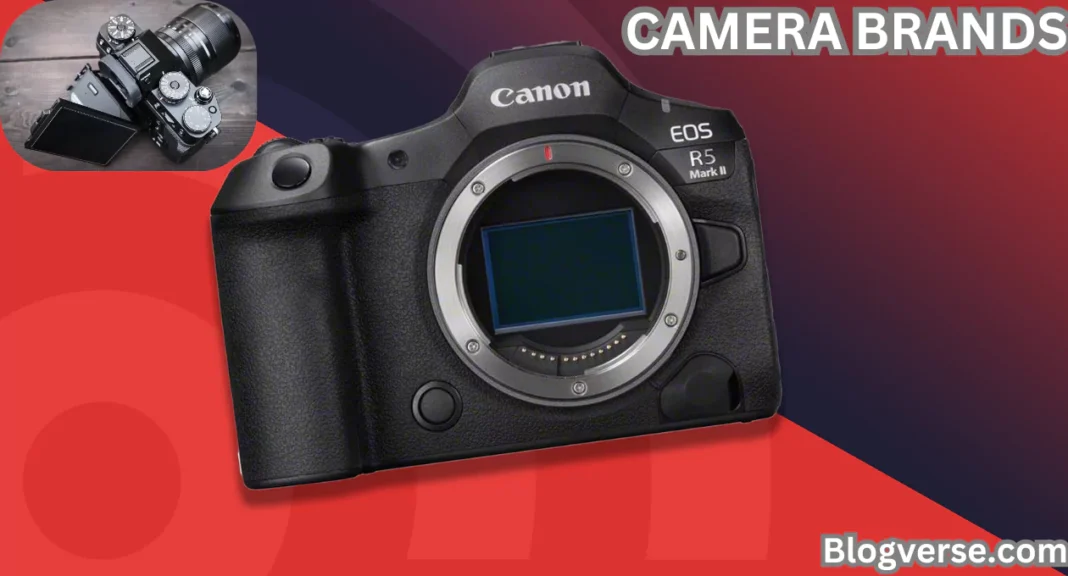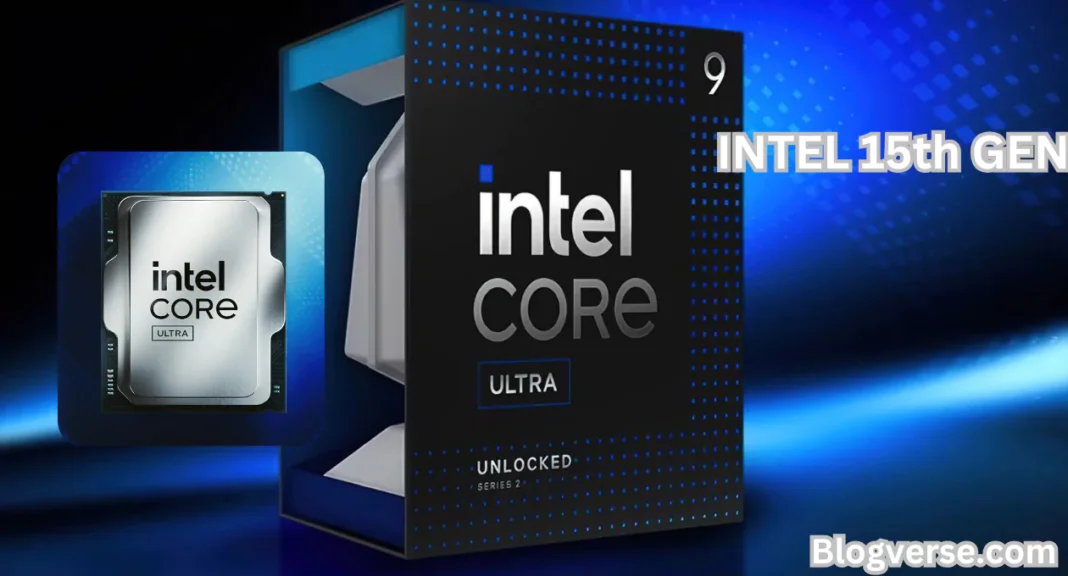Choosing the right camera brands is key to capturing stunning photos, whether you’re an amateur, a hobbyist, or a professional photographer. With new advancements in mirrorless technology, AI-powered autofocus, and high-resolution sensors, 2024 has a range of options for everyone. Here’s a look at the top camera brands of this year, with insights into what each offers.
Canon remains a leading choice for many, offering a blend of tradition and innovation. Their latest models boast impressive features such as dual-pixel autofocus and enhanced low-light performance, making them ideal for both stills and video. Canon’s commitment to interoperability across its range ensures compatibility with a wide range of lenses, catering to diverse photography styles and needs. Whether capturing landscapes or action shots, Canon cameras provide reliability and versatility, appealing to professionals and enthusiasts alike.
Best Camera Brands 2024
In 2024, several camera brands have continued to dominate the market, offering unique features, specialized models, and innovative technologies. Some of the best camera brands include Canon, Nikon, Sony, Fujifilm, Panasonic, Olympus, Leica, Hasselblad, and Pentax. Each brand has carved its niche with different types of users in mind.
For photographers who value exceptional image quality and craftsmanship, Leica continues to stand out. Known for their precision engineering and timeless design, Leica cameras are often seen as a luxury option in the photographic world. In 2024, Leica has introduced new models that combine classic aesthetics with modern technology, including advanced sensor technology and enhanced manual controls.
This makes them ideal for photographers who appreciate the tactile experience of photography and the ability to capture images with exquisite detail and character. Whether used for portraiture, street photography, or fine art, Leica cameras offer a distinctive, premium experience.
Top Camera Brands
Let’s delve into what makes these camera brands stand out:
- Canon – Known for its reliability and exceptional image quality, Canon has a wide range of DSLRs and mirrorless cameras for various budgets.
- Nikon – Competing closely with Canon, Nikon cameras are celebrated for their ergonomics, durability, and high-quality lenses.
- Sony – As a leader in mirrorless technology, Sony cameras boast some of the best autofocus systems and high-speed performance.
- Fujifilm – Known for its retro designs, Fujifilm cameras excel in producing vibrant colors, making them popular among portrait and street photographers.
- Panasonic – Panasonic’s Lumix series is a popular choice among videographers, offering solid performance at a range of prices.
- Olympus – Olympus cameras are known for their compact size and image stabilization, especially in the mirrorless category.
- Leica – A luxury brand, Leica cameras are known for their craftsmanship and stunning image quality, albeit at a premium price.
- Hasselblad – Offering medium-format cameras, Hasselblad is the brand of choice for professionals in fashion and landscape photography.
- Pentax – Known for its rugged DSLR designs, Pentax appeals to those who prefer durable, weather-sealed cameras.
Canon vs. Nikon
The rivalry between Canon and Nikon is legendary in the world of cameras. Both camera brands offer high-quality lenses, exceptional autofocus systems, and user-friendly designs. Canon is often preferred for its videography capabilities, while Nikon’s DSLRs are known for their superior image quality in low light. In the mirrorless world, both brands have advanced options, but Nikon’s Z series and Canon’s R series cater to different niches, with Canon being a better choice for hybrid shooters (photo and video) and Nikon for stills-focused photographers.
Sony continues to push the boundaries of what’s possible in photography with its dedication to cutting-edge technology. In 2024, Sony has launched cameras equipped with state-of-the-art sensors and rapid burst modes, perfect for sports and action photography enthusiasts.
The brand’s mirrorless systems, renowned for their compact design and advanced autofocus, appeal to both professionals and newcomers, providing versatility without sacrificing performance. With innovations in eye-tracking autofocus and superior low-light capabilities, Sony remains a formidable contender in the industry, ensuring every shot is captured with precision and clarity.
Sony Mirrorless Cameras
Sony mirrorless cameras are leaders in the industry, particularly for their innovative autofocus systems and high-quality sensors. Sony’s Alpha series, including models like the A7 IV and A1, are incredibly popular among both amateurs and professionals. Sony’s mirrorless systems are versatile, with options for 4K and even 8K video recording, and have extensive lens compatibility, making them an excellent choice for anyone who wants cutting-edge technology.

Nikon continues to be a prominent name in the photography world, especially noted for its high performance in professional DSLR cameras and its burgeoning line of mirrorless models. The brand is lauded for its exceptional image quality, especially in low-light conditions, making it a favorite among landscape and night photographers.
Nikon’s Z series mirrorless cameras are rapidly gaining recognition for their robust features and incredible resolution, allowing photographers to capture every detail with stunning clarity. Thanks to its extensive range of lenses and accessories, Nikon remains both versatile and adaptive, meeting the diverse demands of photographers worldwide.
Fujifilm Cameras
Fujifilm cameras have a unique appeal with their film-simulation modes, retro aesthetics, and tactile controls. Models like the X-T5 and GFX 100S cater to different user needs, from casual shooters to professional photographers. Fujifilm cameras are especially loved for their color science, making them a favorite for portrait, street, and documentary photography.
Panasonic has made significant strides in the realm of video-centric cameras, thanks to their Lumix series. Known for their robust performance and versatility, these cameras cater to both amateurs and professional videographers. The latest models offer impressive low-light capabilities and internal stabilization, which are highly sought after in the industry. With features such as 6K video recording and advanced color profiles, Panasonic continues to attract creators who seek quality and flexibility in their filmmaking endeavors.
Panasonic Lumix Series
The Panasonic Lumix series is a go-to choice for videographers. Known for their excellent video quality and features, Panasonic Lumix cameras are widely used by content creators and filmmakers. With models like the Lumix GH6 and S5, these camera brands offer high-resolution video, in-body image stabilization, and a variety of professional-grade features.
The innovative design of Olympus cameras ensures that photographers can carry them conveniently to any location. These compact devices offer an impressive balance between portability and performance, featuring advanced stabilization technologies to capture sharp images even in challenging conditions. Their intuitive interface appeals to photographers who prioritize ease of use alongside high image quality. With a range of lenses to choose from, Olympus provides versatile options for capturing everything from wide landscape vistas to intricate close-ups.
Olympus Cameras
Compact and lightweight, Olympus cameras have built a reputation for their impressive in-body image stabilization and durability. Their OM-D series is a popular choice among adventure photographers and vloggers. Although Olympus focuses mainly on the Micro Four Thirds format, they provide excellent portability without compromising image quality.
Leica adds an artistic touch to photography, merging time-honored craftsmanship with contemporary technology. Known for their rich history and precision-engineered camera systems, Leica cameras are celebrated for delivering stunning image quality. Though these camera brands typically come with a steeper price tag, their exceptional lenses and sophisticated designs often make them a worthwhile investment for enthusiasts and professionals alike, providing a unique blend of tradition and innovation in every shot.
Leica Cameras
A premium brand, Leica cameras are known for their craftsmanship, classic designs, and superior image quality. Although they come with a hefty price tag, Leica cameras, like the M11, offer unparalleled image quality, making them a favorite among professional photographers and enthusiasts who value aesthetics and quality.
Olympus continues to stand out not only for its exemplary build quality but also for its commitment to innovation. The camera brands focus on developing user-friendly interfaces ensures that even beginners can feel at ease while capturing high-quality images. Recent models have introduced wireless connectivity features, allowing photographers to transfer images seamlessly to devices, enhancing the workflow and sharing experience. Moreover, Olympus’s dedication to sustainability in their manufacturing processes enhances their reputation among environmentally conscious consumers.
Hasselblad Cameras
For those seeking medium-format photography, Hasselblad is the brand of choice. Known for their stunning image quality and rich details, Hasselblad cameras like the X2D 100C are widely used in fashion, commercial, and fine art photography. While expensive, these camera brands offer exceptional quality and precision.
Zeiss, a brand synonymous with precision optics, crafts lenses that elevate the capabilities of any camera. Their lenses are renowned for their exceptional clarity and color fidelity, making them an ideal choice for photographers who demand excellence. Whether used in portraiture or landscape photography, Zeiss lenses consistently deliver sharpness and depth that can transform an ordinary photo into an extraordinary work of art. This commitment to quality and craftsmanship makes Zeiss a favored choice among discerning professionals and photography enthusiasts alike.
Pentax Cameras
Pentax cameras, particularly their DSLRs, are known for their rugged designs and weather-sealing. They are ideal for outdoor photographers who need durability and reliability in challenging environments. Although Pentax has a smaller market share, it offers excellent value for those who prefer the DSLR format.
One aspect that sets Pentax apart is their commitment to offering in-camera stabilization across a wide array of lenses, providing flexibility and options to photographers without requiring additional equipment. This feature, along with their thoughtful ergonomics and user-friendly interface, ensures that both amateur and seasoned photographers can appreciate Pentax cameras.
Moreover, Pentax’s ongoing emphasis on rugged construction appeals to outdoor enthusiasts who require equipment capable of withstanding the elements. By continuing to advance features while maintaining affordability, Pentax embodies resilience in the competitive landscape of camera manufacturing.
DSLR vs. Mirrorless
One of the biggest debates in the photography world is between DSLR and mirrorless cameras. DSLRs use a mirror mechanism to reflect light into the optical viewfinder, while mirrorless cameras forgo this, making them lighter and more compact. Mirrorless cameras have rapidly gained popularity for their fast autofocus and advanced features. However, some professionals still prefer DSLRs for their longer battery life and rugged build. Choosing between the two camera brands depends on your personal preferences and needs.
The evolution of camera technology has brought a plethora of options for photographers, catering to diverse preferences and styles. With advancements in image processing and sensor design, even entry-level cameras today can produce incredible photos that were once the domain of professional equipment.
The accessibility to high-quality camera brands empowers budding photographers to experiment and hone their craft, while professionals benefit from the precision and control offered by high-end models. As the industry continues to innovate, the line between amateur and professional equipment blurs, democratizing photography like never before.
Camera Brands Reviews
All camera brands come with its strengths and areas where it excels. Canon and Nikon are revered for their versatility and quality lenses, Sony for its mirrorless innovations, and Fujifilm for its color science and aesthetics. Leica and Hasselblad cater to high-end professionals, while Olympus and Pentax offer durable, compact designs for enthusiasts and adventurers.
With the rapid evolution of smartphone technology, mobile photography has become increasingly sophisticated. Modern smartphones now feature advanced camera systems with multiple lenses and computational photography capabilities.
This allows users to capture high-quality images with ease, often rivaling traditional cameras. Additionally, the convenience of always having a phone on hand empowers people to document their daily lives, fostering a new generation of photographers. As a result, mobile photography has democratized the art form, making it accessible to a broader audience than ever before.
Professional Camera Brands
When it comes to professional camera brands, Canon, Nikon, Sony, Fujifilm, Leica, and Hasselblad are among the top choices. These camera brands offer full-frame and medium-format cameras, catering to different genres from portrait and sports to landscape and fine art photography. They are often equipped with the latest technologies, such as high-resolution sensors, dual card slots, and advanced autofocus systems.
Budget Camera Brands
For those starting out or with limited budgets, Canon, Nikon, Sony, Panasonic, and Olympus offer excellent entry-level models that balance quality and affordability. Canon’s Rebel series and Nikon’s D3000 series are ideal for beginners, while Sony’s a6000 series and Panasonic’s Lumix G-series provide great options in the mirrorless category.
FAQs
What is the main difference between DSLR and mirrorless cameras?
DSLR cameras use a mirror mechanism to reflect light into the optical viewfinder, while mirrorless cameras do not have a mirror box, offering a lighter and more compact design. Mirrorless cameras also typically feature faster autofocus and incorporate more advanced technologies than DSLRs.
Why should I choose a medium-format camera over a full-frame camera?
Medium-format cameras, such as those offered by Hasselblad, provide superior image quality with greater detail and dynamic range than full-frame cameras. They are particularly favored in fields like fashion and fine art photography, where image precision is paramount. However, they tend to be more expensive and are generally bulkier, making them less ideal for casual or portable photography needs.
What are the advantages of using a smartphone for photography?
Smartphones offer convenience and versatility, with advanced camera systems that often include multiple lenses and software enhancements for computational photography. These features allow users to capture high-quality images on the go and share them easily, democratizing photography by making it accessible to a wider audience.
How important is weather sealing in a camera?
Weather sealing is crucial for photographers who frequently shoot in unpredictable or challenging environments, such as rain, snow, or dusty conditions. It protects the camera’s internal components from moisture and debris, thereby extending the camera’s lifespan and ensuring reliable performance under adverse conditions.
Which camera brands are best for beginners?
For beginners, camera brands like Canon, Nikon, Sony, Panasonic, and Olympus offer a range of entry-level models that provide a balance of quality and affordability. Canon’s Rebel series and Nikon’s D3000 series are particularly user-friendly options for those new to photography.
In Summary
All camera brands offer unique features tailored to different needs and skill levels. Whether you’re a professional looking for top-notch image quality or a hobbyist wanting a reliable camera on a budget, there is a brand and model out there that will fit your needs.
Photography also sees the use of drones, which have transformed how we capture landscapes and events from aerial perspectives. Offering stunning angles and previously unattainable views, drones are equipped with high-resolution cameras, allowing for creative expression in both photography and videography.
Their ability to fly over vast areas provides photographers with the flexibility to explore new vantage points, making them an invaluable tool for capturing dynamic scenes from the sky. With advancements in technology, drones continue to push the boundaries of modern photography, offering photographers unprecedented opportunities to showcase the world from above.
For more amazing information keep visiting Blogverse.



